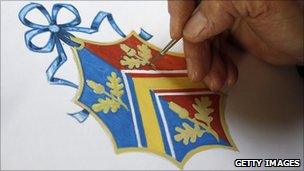Who, What, Why: How do you get a coat of arms?
- Published

Kate Middleton's family can now boast of its own heraldry
A coat of arms has been granted to Kate Middleton's family ahead of the royal wedding. How do you acquire such a design?
Her parents may have been an ex-flight dispatcher and a former air stewardess descended from a miner, but an absence of noble blood has not prevented the family of Kate Middleton having a coat of arms drawn up for them.
Generic family heraldic designs may be widely sold in gift shops and hung in the living rooms of the socially aspirational.
But for any British person to have a legal right to a coat of arms it must have been granted to them or they must be descended in the male line from a person to whom arms were awarded. Organisations can also be granted a coat of arms.
In England, where the Middleton's design was carried out, there are no fixed eligibility criteria for new commissions, but factors such as honours from the Crown, civil or military commissions, university degrees and professional qualifications and "eminence or good standing in national or local life" are taken into account.
In Scotland, the Lord Lyon King of Arms enforces the law of arms under criminal jurisdiction. In the rest of the UK, the use of arms is a matter of civil law and regulated from the College of Arms and the Court of Chivalry.
Thomas Woodcock, Garter Principal King of Arms - a position created in 1415 by King Henry V on the way to the Battle of Agincourt - says more people are eligible to have their own coat of arms than is generally realised.
"Tests for eminence are very wide in that they include possession of a university degree or a professional qualification," he says.
"A great many people in the country could, if they wish, have a coat of arms, but if we were to advertise too much it would debase our own currency."
He says coats of arms date back to the 12th Century, when they were worn over armour in battle and in tournaments so that opponents could identify each other.

The Middleton family coat of arms references Carole Middeton's maiden name
Families originally assumed their own coat of arms, and in cases where two clans used the same design, there would be a case in the High Court of Chivalry to decide who had the better right.
In 1484, the College of Arms was incorporated to administer the system.
Mr Woodcock says each design must be unique and have at least two "linear differences" so that it can be distinct if shown in black and white.
As a family has legal ownership of its coat of arms, a case could technically be brought in the Court of Chivalry if designs were too similar or if someone used another person's heraldry.
No such action has been taken since 1954 when Manchester Corporation successfully sued the Manchester Palace of Varieties for using its coat of arms.
In the case of the Middletons, the grant is made to Kate's father Michael Middleton because the coat of arms is passed down the male line. This allows Kate's siblings to use the design.
Kate will only be able to use the coat of arms until her wedding day on 29 April. After the marriage ceremony, her design will be combined with that of Prince William - a process known as "impaled arms".
Theirs is made up of shield divided vertically into blue and red, with a gold chevron in the centre. Mr Woodcock says this is a reference to Goldsmith, the maiden name of Kate's mother Carole Middleton.
Additionally, the chevron includes three sprigs of oak - a reference both to Mr and Mrs Middeton's three children and the fact that the area around their Berkshire home includes many oak trees.
The legal document formally granting Mr Middleton his coat of arms is written on vellum parchment, decorated by a herald painter, with the text written by a scrivener.
Charles Mosley, a genealogist and former editor-in-chief of Burke's Peerage & Baronetage, says new peers are routinely offered the chance to have a coat of arms drawn up for them, but, with the process costing £4-5,000, many don't bother "on cost grounds and because of inverted snobbery".
He adds: "The significance in terms of social standing these days is virtually nil. Most wealthy people don't see why they should bother."